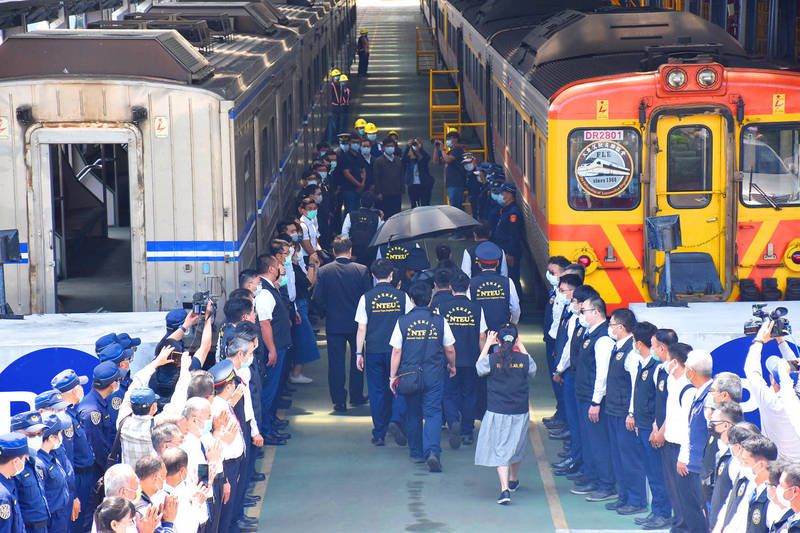《TAIPEI TIMES》 Truck slid onto tracks a minute before collision

People bid farewell to train driver Yuan Chun-hsiu, who was killed in a train crash on Friday last week, as railway police escort his ashes and family members to a train departing from Hualien County for his hometown of Taichung yesterday. Photo: CNA
NO TIME: The driver tried to apply the brakes when he saw the truck, but the train did not have time to come to a full stop, an investigation report said
By Shelley Shan / Staff reporter
The crane truck that caused last week’s fatal train accident had slid onto the tracks about one-and-a-half minutes before it was struck, the Taiwan Transportation Safety Board said yesterday.
The board had launched an investigation into the derailment, which killed 50 people and injured 211 people, making it the nation’s most devastating railway accident in decades.
Carrying 494 passengers and four Taiwan Railways Administration personnel, the southbound express train to Taitung hit the truck as it was about to enter the Cingshuei Tunnel (清水隧道) in Hualien’s Sioulin Township (秀林).
The train derailed following the collision, with the left side of the eighth carriage completely destroyed. The seventh carriage was severely deformed and detached from the sixth carriage, the board said.
The fourth, fifth and sixth carriages were twisted as well, it said.
Board investigators tried to reconstruct the accident from data retrieved from the train’s dashcam, an onboard automatic train protection system, train control management system, a vehicle data recorder (VDR) on the crane truck, and footage from surveillance cameras along a nearby highway and other data, board chairman Young Hong-tsu (楊宏智) said.
The crane truck entered the construction site at 8:49am on Friday, carrying a load of used tires, an investigation report said.
VDR data showed that there were other vehicles operating on site, including excavators and motorcycles, the board’s Rail Occurrence Investigation Division convener Li Gang (李綱) said.
The Taiwan Railways Administration said that it had informed contractors that they had to stop all construction work during the Tomb Sweeping Day long weekend.
The board also traced the movement of the crane truck from the VDR data, which showed that it slid down from the top of a slope and was stuck in the bushes when it hit a curve.
The VDR on the truck stopped recording after the truck’s engine was turned off, Li said.
“Based on footage from surveillance cameras and our on-site observation, we infer that the truck fell downhill through a treeless patch on the side of the slope after the engine was turned off and fell on the railroad, with the front of the truck facing the Heren Tunnel (和仁隧道), from which the Taroko Express emerged. A head-on collision ensued about one-and-a-half minutes after the truck flipped over onto the tracks,” Young said.
Asked if the driver left the truck after the engine was turned off, Young said that such information would be disclosed at the discretion of prosecutors.
Dashcam footage from the train showed that the driver could see the truck when the train emerged from the Heren Tunnel.
The train was traveling at 125kph, which means it would have needed 500m to 600m to come to a full stop.
The truck was about 240m from the Heren Tunnel, Young said.
Data from the train control management system showed the train driver and his assistant trying to stop the train by applying the brakes, but they only managed to slow it to 121kph.
The board found that the truck’s brake system was modified as well, Li said.
The board has disclosed about 70 to 80 percent of the evidence gathered on site during the holiday, Young said, adding that it would publish a complete report within four months.
新聞來源:TAIPEI TIMES




















